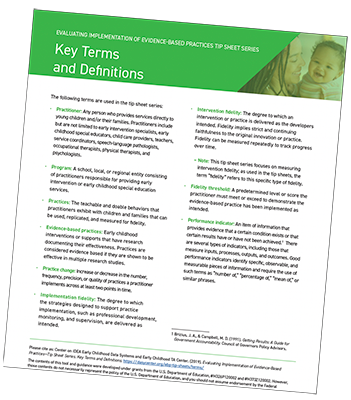Terms
The following terms are used in the tip sheet series:
- Practitioner: Any person who provides services directly to young children and/or their families. Practitioners include but are not limited to early intervention specialists, early childhood special educators, child care providers, teachers, service coordinators, speech-language pathologists, occupational therapists, physical therapists, and psychologists.
- Program: A school, local, or regional entity consisting of practitioners responsible for providing early intervention or early childhood special education services.
- Practices: The teachable and doable behaviors that practitioners exhibit with children and families that can be used, replicated, and measured for fidelity.
- Evidence-based Practices: Early childhood interventions or supports that have research documenting their effectiveness. Practices are considered evidence based if they are shown to be effective in multiple research studies.
- Practice Change: Increase or decrease in the number, frequency, precision, or quality of practices a practitioner implements across at least two points in time.
- Implementation Fidelity: The degree to which the strategies designed to support practice implementation, such as professional development, monitoring, and supervision, are delivered as intended.
- Intervention Fidelity: The degree to which an intervention or practice is delivered as the developers intended. Fidelity implies strict and continuing faithfulness to the original innovation or practice. Fidelity can be measured repeatedly to track progress over time.
Note: This tip sheet series focuses on measuring intervention fidelity; as used in the tip sheets, the term “fidelity” refers to this specific type of fidelity. - Fidelity Threshold: A predetermined level or score the practitioner must meet or exceed to demonstrate the evidence-based practice has been implemented as intended.
- Performance Indicator: An item of information that provides evidence that a certain condition exists or that certain results have or have not been achieved.[1] There are several types of indicators, including those that measure inputs, processes, outputs, and outcomes. Good performance indicators identify specific, observable, and measurable pieces of information and require the use of such terms as “number of,” “percentage of,” “mean of,” or similar phrases.
1 Brizius, J. A., & Campbell, M. D. (1991). Getting Results: A Guide for Government Accountability. Council of Governors Policy Advisors.
The contents of this tool and guidance were developed under grants from the U.S. Department of Education, #H326P120002 and #H373Z120002. However, those contents do not necessarily represent the policy of the U.S. Department of Education, and you should not assume endorsement by the Federal Government. Project Officers: Meredith Miceli, Richelle Davis, and Julia Martin Eile.


 Download
Download